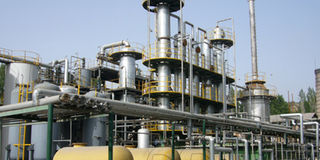Why TZ fails to industrialise despite multitude of policies

One of the industries that are available in the country. Tanzania has not made a big stride in industrialisation because of poor implementation of its policies. PHOTO| FILE
What you need to know:
Tanzania is implementing its much-touted industrialization drive but the country has drafted many industry-related policies since independence. Some policies are said to have been copied by other countries and worked there. However, the main challenge for Tanzania is implementing the policies which experts say are sometimes beyond the government’s capacity.
Dar es Salaam. Tanzania’s gradual path to an industrial economy has been adventurous, full of challenges and, mostly, difficult.
However, all this is not due to lack of policies because Tanzania has drafted many policies for transforming the industrial sector since independence. Some of these policies were weak and some strong, but the main problem, as often pointed out by academicians, has been poor implementation. “The results in terms of industrial development have failed to keep pace with the rhetoric,” says John Page from the Brookings Institution.
And so goes the adage: “Policies are crafted in Tanzania, improved in Uganda and implemented in Kenya.”
Existing policy framework
The current industrial policy direction points to deepening the private sector-led industrial growth as a way of transforming the economy from its heavy reliance on agriculture. Two major policy documents cater for economic transformation through industrialisation. They are the Tanzania Development Vision (TDV) 2025 and the Sustainable Industrial Development Policy for Tanzania (SIDP 2020).
Vision 2025
Drafted in 1999, the Development Vision 2025 aims at propelling Tanzania from a least developed country to a middle income country with a high level of human development, and whose economy is diversified and semi-industrialised. “This aimed at raising agricultural productivity by embracing science and technology. It also focussed on value addition and promoting inter-sectoral linkages,” reads a policy analysis report by Repoa.
According to experts, the Vision 2025 marks an important milestone in Tanzania’s industrial policy-making by emphasising the desire to move once and for all from an agricultural economy to a semi-industrialised one.
The mistake that Tanzanian policy-makers made, however, and which became the biggest impediment to the implementation of the vision, was the failure to put in place a framework for its implementation during the inception stage, according to the Tanzania Industrial Competitiveness Report 2012.
Industrial development policy
The Sustainable Industrial Development Policy 2020, on the other hand, seeks to facilitate shifting the economy’s engine of growth from the public to the private sector.
The Industrial Policy was formulated in 1996 after a decade of adopting the Structural Adjustments Programmes imposed by the multilateral institutions on Tanzania and which had dealt the country’s economy a massive blow, leading to an industrial growth slump.
The idea of creating the Industrial Policy “was to consolidate, in the short run, the existing national capabilities in the industrial sector, and to build up new capacities in activities with competitive advantages for export markets in the medium term,” reads part of the report of the Industrial Competitiveness report.
The Industrial Policy would guide the promotion of the private sector to take the lead in industrialisation while the government would be responsible for putting in place a conducive policy and regulatory environment and requisite infrastructure.
“The government would only invest directly in industrial ventures, which are strategic and of critical national economic importance such as iron and steel industry,” reads a Repoa policy analysis document.
SIDP was to be implemented in three phases with Phase I (1996-2000) being a short-term programme meant to rehabilitate and consolidate existing industrial capacities.
Phase II (2000-2010) was a medium-term programme, which aimed at generating new capacities in areas with potential of creating competitive advantage through the use of efficient technology.
In this phase, the emphasis was put on initiating production of intermediate goods. Phase III (2010-20) encompassed a long-term programme to achieve major investments in basic capital goods industries to ensure consolidation of the industrial structures developed in the first two phases.
Policy implementation
Several strategies and plans have been crafted to facilitate the implementation of the major policies.
As pointed out earlier, however, most of these implementation frameworks came late.
The Integrated Industrial Development Strategy 2025 was formulated and adopted in 2010 with a view to providing concrete strategies to implement SIDP 2020 and build a competitive industry by putting in place a competitive business environment.
The strategy was adopted four years after the SIDP 2020 had been drafted to bolster efforts of achieving the SIDP goal of accelerating industrialisation and providing concrete strategies to implement the strategy. The strategy, which was also meant to harmonise the SIDP 2020 and the Vision 2025, targeted six sub-sectors namely agro-processing, textiles, leather, fertiliser and chemicals, light machinery and iron, and steel.
Mini-Tiger Plan 2020.
In 2005 the government came up with the Tanzania Mini-Tiger Plan 2020 to fast-track the implementation of Vision 2025 by adopting the Asian Tigers model.
This came six years after the vision’s documents were seemingly dumped in shelves.
The Mini-Tiger plan states that “the successful development of the manufacturing sector is the formula, which all economically thriving Asian countries followed and it is not an exaggeration to say that the sector’s success holds the key of the nation’s further development.”
It is the Mini-Tiger Plan that led to the introduction of Special Economic Zones and Export Processing Zones, which have been implemented with mixed outcomes.
Long-Term Perspective Plan (LTPP) 2011/12-2025/26 was another plan developed to help the implementation of the Vision 2025. The Long-Term Plan has been divided into three five-year plans to simplify its execution. The FYDP I (2011/12-2015/16) was to focus on building the requisite infrastructure, improve energy supply and markets.
The FYDP II (2016/17-2020/21), which has just been tabled in Parliament, is intended to deepen industrialisation as the key pillar of socio-economic and political development while the FYDP III (2021/22-2025/26) will focus on further promoting the competitiveness of the manufacturing sector and a substantial improvement in Tanzania’s share in global and regional trade.
Other industrial policies
The National Trade Policy 2003: This policy was developed by the ministry of Industry and Trade and strictly followed the principles stated in the Vision 2025 by focusing on the private sector-led export growth. The National Trade Policy 2003 emphasised on stimulation and encouragement of value addition as one of its main objectives.
Criticism of implementation
Industrial strategies and plans, especially those created to support the SIDP and the Vision 2025 are too many, according to experts.
“In many cases these proposed policies possibly are beyond the government’s capacity to implement,” says Prof Samwel Wangwe in a paper titled Tanzania Industrialisation Report.




